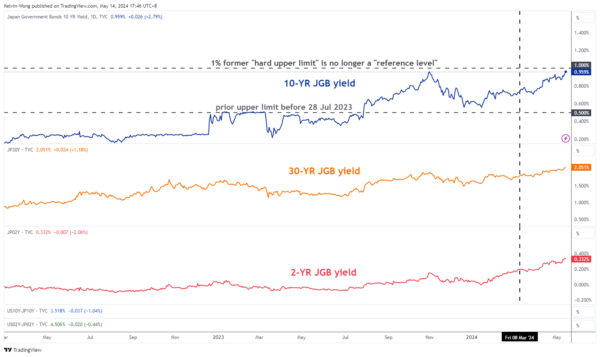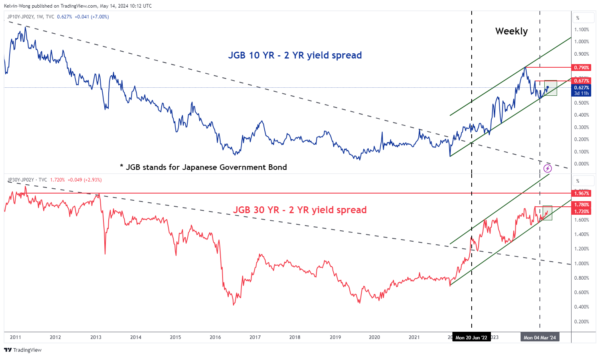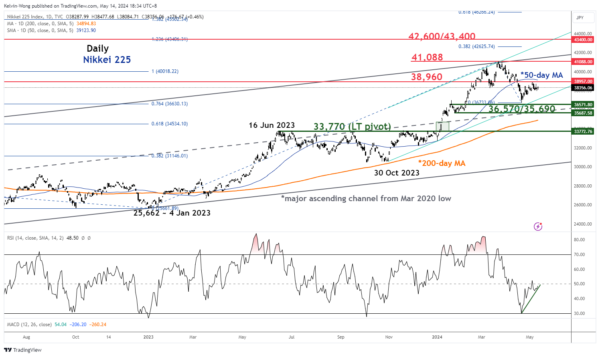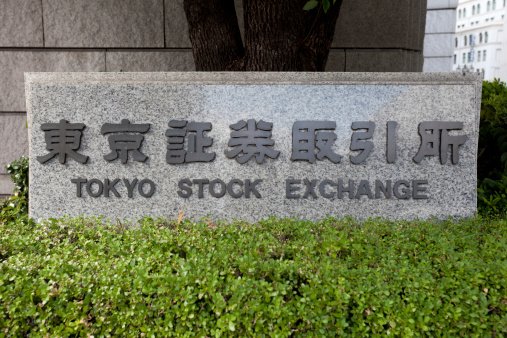-
- Nikkei 225 has undergone a 4-week corrective decline of 10.6% since its 41,088 all-time high printed on 22 March.
- Nikkei 225 major uptrend phase in place since 4 January 2023 remains intact.
- BoJ’s recent announcement on its reduction of 5 to 10-year JGBs purchases has led to a spiked up in JGBs yields that implied BoJ may have loosened its grip on “yield control”.
- A further steepening on the JGBs yield curve may trigger a positive feedback loop back into the Nikkei 225.
The Japanese stock market has been on a multi-year bullish run since October 2022 with the benchmark Nikkei 225 hitting a fresh all-time high of 41,088 on 22 March, which surpassed its prior secular peak of 38,957 printed in December 1989 before the onset of multi-decades-long of deflationary spiral inflicted on the Japan economy triggered by the major burst of the Japanese property bubble.
A major feat that has taken almost 34 years to achieve which implies that the Japanese stock market is likely seeing a major shift unfolding in local investors’ risk appetite towards more risk-seeking behaviour aided by a push of stock market-friendly initiatives by the Japanese government such as corporate reforms that unlocked substantial shareholders’ value and a new tax exemption programme (Nippon Individual Savings Account) targeted on retail stock investors.
Since our last publication, the Nikkei 225 staged a decline in April with a monthly loss of -4.9% in line with the major US stock indices, but so far its performance has been lacklustre as it underperformed against several major global benchmark stock indices with a month-to-date loss of -0.13% in May versus recoveries seen in the S&P 500 (+3.7%), Hang Seng Index (+7.4%), and German’s DAX (+4.5%) over the same period at this time of the writing.
A deceleration in Tokyo’s inflation trend does not bode well for Japanese equities
The current underperformance of the Nikkei 225 is likely driven by the recent deceleration of Tokyo’s core-core inflation trend (excluding fresh food and energy) slowing to 1.8% y/y in April from 2.9% y/y in March, which is a dip below Bank of Japan (BoJ)’s inflation target of 2% set on national wide Japan’s core-core inflation rate, rising alarm of a resurgence of deflation risk in the Japan economy, in turn, may trigger a holdback of Japanese corporate fixed investment plans and consumer spending.
On 19 March, BoJ ended its short-term negative interest rate regime and scrapped its yield curve control (YCC) programme on the 10-year Japanese Government Bond (JGB) but maintained an indirect accommodative stance by continuing to purchase JGBs with broadly the same amount and with the option to increase its JGBs purchases to negate a rapid rise in long-term interest rates.
Hence BoJ’s actions have implied that it is still uncomfortable to allow market forces to dictate the movement of long-term JGBs yields which can dampen Japanese banks’ net profits via a lack of expansion in net interest income margins and slow down the repatriation of fixed income investments from abroad which had likely triggered a negative feedback loop back into the Nikkei 225.
2-year and 10-year JGB yields spiked to more than a decade high

Fig 1: JGBs yields medium-term trends as of 14 May 2024 (Source: TradingView, click to enlarge chart)
On Monday, 14 May, BoJ announced that it will reduce its long-term 5 to 10-year JGBs purchases at each of its funds-supplying operations; the purchase will be pegged at around 425 billion yen, downed from 475 billion yen.
This latest news flow has led the JGBs yields to continue their upward climb in place since early March with more gusto. The 2-year JGB yield (more sensitive to BoJ’s policy interest rate) inched higher to 0.33%, its highest level since May 2009. In addition, the 30-year JGB yield also rallied to 2.05%, the highest level since July 2011 (see Fig 1).
Longer-term JGB yields are rising at a faster rate versus the 2-year JGB yield

Fig 2: JGBs yield spreads (10-YR/2-YR & 30-YR/2-YR) major & medium-term trends as of 14 May 2024 (Source: TradingView, click to enlarge chart)
Interestingly, the current pace of the rally seen in the JGBs yields is more pronounced on the longer end of the curve where the yield spread of the 30-year over the 2-year has steepened further since early March. Based on a technical analysis perspective, the 30-year/2-year JGB yield spread is evolving within a medium-term uptrend phase reinforced by its major bullish breakout triggered in late June 2022 (see Fig 2).
The next medium-term resistance stands at 1.97% after its recent swing high of 1.78% printed in January 2024 which suggests that the 30-year/2-year JGB yield spread may steepen further; triggering a positive boost to the Nikkei 225.
Watch the 38,960 resistance on the Nikkei 225

Fig 3: Nikkei 225 major & medium-term trends as of 14 May 2024 (Source: TradingView, click to enlarge chart)
Since its 19 April low of 36,733, the price actions of the Nikkei 225 have been compressed to a narrowing range configuration (see Fig 3).
On the positive side, the medium-term momentum condition is slightly bullish as indicated by upward sloping daily RSI momentum indicator that continued to inch higher toward the 50 level from its oversold region.
Therefore, a clearance above the intermediate resistance of 38,960 (also the 50-day moving average) may trigger a medium-term bullish breakout condition on the Nikkei 225 that is likely to unleash another potential bullish impulsive upmove sequence with the next medium-term resistance zone coming in at 42,600/43,400 after its current all-time high of 41,088.
However, a break below the 36,570/35,690 key medium-term pivotal support invalidates the bullish tone to expose the 33,770 key long-term support.









